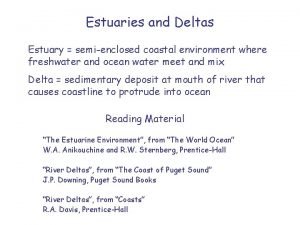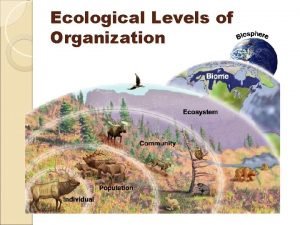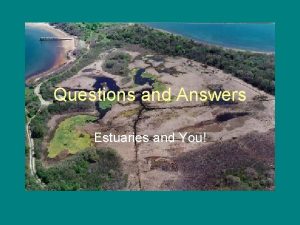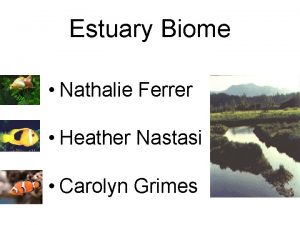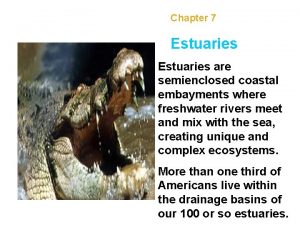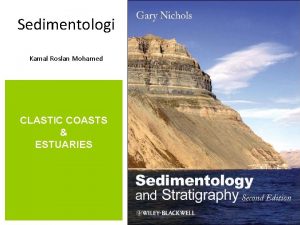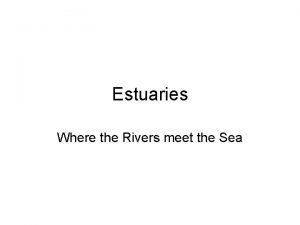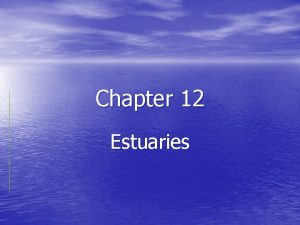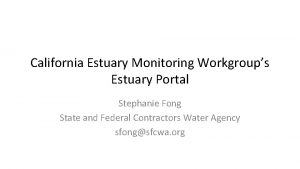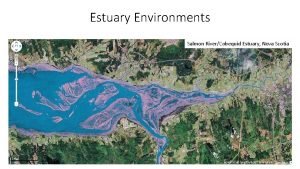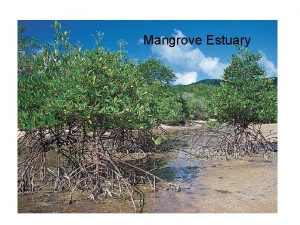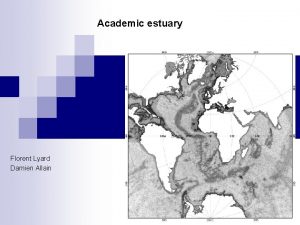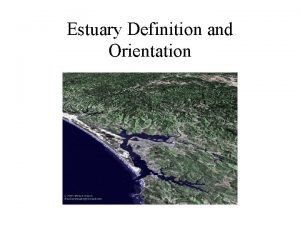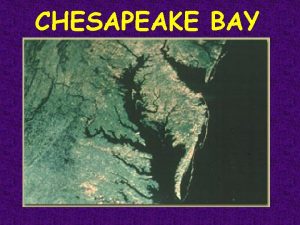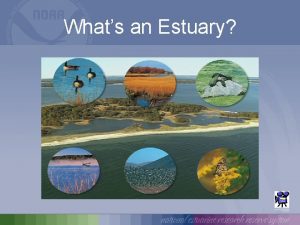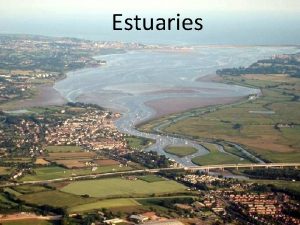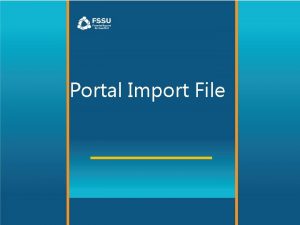California Estuary Monitoring Workgroups Estuary Portal Instructions for

























































- Slides: 57

California Estuary Monitoring Workgroup’s Estuary Portal Instructions for 34 North • This pages are for general layout guidance and for guidance on the Questions/Answered Box development. Text in the main part of each page doesn’t not reflect recent edits and should not be used. The text that should be used in those areas is the text that has been loaded into the estuary workgroup website. 1

Home Safe to Drink Safe to Swim Safe to Eat Fish Ecosystem Health Stressors & Processes Contact Us …………………. . ………………………………………………………………. . ……… Ø Cal/EPA Ø Natural Resources Agency Ø About the California Water Quality Monitoring Council ESTUARIES Ø Stressors Ø Laws, Regulations & Standards Ø Research Ø Monitoring Programs, Data Sources & Reports Ø Restoration & Management Instructions for left navigation bar: Estuaries: links to the “California Estuaries” introduction page (slide 3) Laws, Regulations, and Standards: links to the “What’s being done to protect California’s estuaries (slide 6) Research: links to “What research is being performed in the SF Estuary? ” (slide 8) Monitoring…: links to the “what monitoring programs…” (slide 9) Restoration and Management: can we get rid of this link for now? Combined this information with research 2

Home Safe to Drink Safe to Swim Safe to Eat Fish Ecosystem Health Stressors & Processes Contact Us Home Eco Health Estuaries California Estuaries …………………. . ………………………………………………………………. . ……… QUESTIONS ANSWERED Ø Cal/EPA Ø What are estuaries, and why are Ø Natural Resources Agency they important? Ø Where are California’s estuaries? Ø About the California Water Quality Monitoring Council Ø How healthy are California’s estuaries? Ø What’s being done to protect ESTUARIES California’s estuaries? Ø Stressors Ø How can I be part of the solution? Ø Laws, Regulations & Standards Ø Research Ø Monitoring Programs, Data Sources & Reports Ø Restoration & Management What are estuaries? Estuaries are partly enclosed bodies of water where fresh water coming down the rivers mixes with salt water from the sea. A range of coastal landforms fits this description, including bays, harbors, inlets, lagoons, and some wetlands. There are many types of estuaries in California including • bar-built, [opens wiki] 3

Home Safe to Drink Safe to Swim Safe to Eat Fish Ecosystem Health Stressors & Processes Contact Us Home Eco Health Estuaries Where Are California’s Estuaries? …………………. . ………………………………………………………………. . ……… QUESTIONS ANSWERED Ø Cal/EPA Ø Natural Resources Agency Ø About the California Water Quality Monitoring Council ESTUARIES Ø Stressors Ø Where are California’s estuaries? Ø San Francisco Estuary Ø Santa Monica Bay Ø Elkhorn Slough Ø Morro Bay Estuary Ø Smith River Estuary Ø Klamath River Estuary Ø Mad River Estuary Ø Laws, Regulations & Standards Ø Noyo River Estuary Ø Research Ø Russian River Estuary Ø Monitoring Programs, Data Sources & Reports Ø Restoration & Management Ø Eel River Estuary Hundreds of estuaries are found in California, including the San Francisco Estuary (SF Estuary), Santa Monica Bay, and Morro Bay Estuary among others. The goal of the California Estuaries Portal is to provide comparable information on each of these estuaries. The first step in building the portal is focused on California’s largest estuary, the SF Estuary. Information describing the health of California’s other estuaries will follow. 4

Home Safe to Drink Safe to Swim Safe to Eat Fish Ecosystem Health Stressors & Processes Contact Us Home Eco Health Estuaries Health How Healthy Are California’s Estuaries? …………………. . ………………………………………………………………. . ……… QUESTIONS ANSWERED Ø Cal/EPA Ø How healthy are Ø Natural Resources Agency Ø About the California Water Quality Monitoring Council ESTUARIES California’s estuaries? Ø SF Estuary Health Water Habitat Living Resources Ecological Stewardship Processes Ø Stressors Ø Laws, Regulations & Standards Ø Research Ø Monitoring Programs, Data Sources & Reports Ø Restoration & Management How healthy are California’s estuaries? The health of each of California’s estuaries is an estimate of the overall condition of the ecosystem. The health of an estuary as a whole depends on the condition of individual ecosystem elements that combine to create the estuary. This is similar to the health of the human body which is dependent on the health of individual parts like the brain, heart, and bones. Estimating the health of the SF Estuary is the first step in building the My Water Quality Portal that answers the question “Are Our Estuaries Healthy? ” Estimating the health of California’s other estuaries will follow. 5

Home Safe to Drink Safe to Swim Safe to Eat Fish Ecosystem Health Stressors & Processes Contact Us Home Eco Health Estuaries Protection What Is Being Done To Protect California’s Estuaries? …………………. . ………………………………………………………………. . ……… Ø Cal/EPA Ø Natural Resources Agency Ø About the California Water Quality Monitoring Council ESTUARIES Ø Stressors Ø Laws, Regulations & Standards California’s estuaries, and the organisms that live in them, are protected by many State and federal laws, regulations, and policies designed to prevent the degradation and destruction of • • Water Quality, Habitat, Living Resources, and Ecological Processes. QUESTIONS ANSWERED Ø What’s being done to protect California’s estuaries? Ø Laws, Regulations, and Polices Some of these protections, which government agencies enforce and uphold, and how they relate to CA Estuaries are described below. Ø Stewardship Please note: Simply having laws, regulations, and policies in place is not enough to protect California's estuaries and other natural resources. Constant vigilance and effort are necessary to ensure healthy ecosystems and the continued existence of rare and listed species. The initial focus of the Portal is on a description of the policies and programs protecting the SF Estuary. More information on other California estuaries is under development. Ø Research Ø Monitoring Programs, Data Sources & Reports Ø Restoration & Management What Federal Laws, Regulations, and Policies Protect California’s Estuaries? (links to the federal part of the laws and regs page [next slide]) What State Laws, Regulations, and Policies Protect California’s Estuaries? [links to the state part of the 6

Home Safe to Drink Safe to Swim Safe to Eat Fish Ecosystem Health Stressors & Processes Contact Us Home Eco Health Estuaries Protection Laws What Laws, Regulations, And Policies Protect California’s Estuaries? QUESTIONS ANSWERED …………………. . ………………………………………………………………. . ……… Ø What’s being done to protect What Federal Laws, Regulations, and Policies Protect California’s Estuaries? Ø Cal/EPA Ø Natural Resources Agency Clean Water Act (CWA) ESTUARIES EPA logo USFWS logo Ø Laws, Regulations & Standards Ø Research Ø Monitoring Programs, Data Sources & Reports Ø Restoration & Management Ø What laws, regulations, and polices protect California’s estuaries? Ø About the California Water Quality Monitoring Council Ø Stressors California’s estuaries? USACE logo Ø Federal Ø State Ø SF Estuary Policies and Purpose: To govern water pollution and regulate water quality standards for surface waters Plans Agencies: US Army Corps of Engineers (USACE) Responsible for managing the nation’s waterways and wetlands. US Environmental Protection Agency (USEPA) Responsible for regulating water quality standards and overseeing USACE regulatory activities How This Relates to CA Estuaries: The health of California estuaries and estuarine species depend on water quality. Habitat, living resources, and ecosystem processes thrive with clean water. Regulations under CWA Section 401 Certification Purpose: Requires federal agencies to certify that their actions under CWA Section 404 do not violate state water quality standards Agency: State and Regional Water Boards How This Relates to CA Estuaries: Section 401 of the CWA ensures that federal 404 permits within California do not harm estuarine ecosystems by impacting water quality with the discharge of dredged or fill material. Wetlands, riparian areas, and headwaters are vulnerable to filling, which can affect the health of these areas. Section 404 Permits Purpose: To regulate the discharge of dredged or fill material (such as soil or sediments) into waters of the US 7

Home Safe to Drink Safe to Swim Safe to Eat Fish Ecosystem Health Stressors & Processes Contact Us Home Eco Health Estuaries Research What Research Is Being Performed In The SF Estuary? …………………. . ………………………………………………………………. . ……… Ø Cal/EPA Many groups are conducting and funding original research in the SF Estuary, including those listed below. This is not an exhaustive list. Ø Natural Resources Agency • CA Department of Fish and Wildlife Ecosystem Restoration Program Ø About the California Water Quality Monitoring Council • Delta Science Program • Grants • Fellows ESTUARIES Ø Stressors Ø Laws, Regulations & Standards • Interagency Ecological Program • National Science Foundation • Point Blue Conservation Science (PRBO) • San Francisco Estuary Institute Ø Research • San Francisco Invasive Spartina Project Ø Monitoring Programs, Data Sources & Reports • San Francisco National Estuarine Research Reserve System (link to http: //www. sfbaynerr. org/ and http: //www. yourwetlands. org/) Ø Restoration & Management • University of California, Davis • State and Federal Contractors Water Agency • University of California, Davis Information Center for the Environment • University of California, Berkeley • University of California, Santa Barbara, National Center for Ecological Analysis and Synthesis • U. S. Geological Survey 8

Home Safe to Drink Safe to Swim Safe to Eat Fish Ecosystem Health Stressors & Processes Contact Us Home Eco Health Estuaries Monitoring What Monitoring Programs, Data Sources, And Reports Are Available? …………………. . ………………………………………………………………. . ……… Ø Cal/EPA Ø Natural Resources Agency Ø About the California Water Quality Monitoring Council ESTUARIES Ø Stressors Ø Laws, Regulations & Standards Ø Research Ø Monitoring Programs, Data Sources & Reports Ø Restoration & Management Many groups are monitoring and reporting various water-related components in the SF Estuary, including those listed below. The Central Valley Monitoring Directory is a good source of metadata for much of the monitoring being performed in the Central Valley. Monitoring Programs (link to section below) Additional Data Sources (link to section below) Reports (link to section below) Monitoring Programs CA Department of Fish and Wildlife CA Department of Pesticide Regulation CA Department of Water Resources Water Data Library Interagency Ecological Program Irrigated Lands Regulatory Program Point Reyes Bird Observatory Conservation Science – San Francisco Bay Program San Francisco Bay Joint Venture San Francisco Bay Regional Monitoring Program San Francisco Invasive Spartina Project Surface Water Ambient Monitoring Program U. S. Fish and Wildlife Service Additional Data Sources CA Environmental Data Exchange CA Data Exchange Center U. S. Geological Survey National Water Information System Reports Delta Bay-Delta Strategic Workplan Ca Department of Fish and Wildlife Ecosystem Restoration Program Conservation Strategy 9

Home Safe to Drink Safe to Swim Safe to Eat Fish Ecosystem Health Stressors & Processes Contact Us Home Eco Health Estuaries Where San Francisco What Is The San Francisco Estuary, And Why Is It Important? …………………. . ………………………………………………………………. . ……… QUESTIONS ANSWERED Ø Cal/EPA Ø Natural Resources Agency Ø What is the San Francisco Estuary, and why is it Ø About the California Water Quality Monitoring Council ESTUARIES important? Ø How healthy is the SF Estuary? < Ø Stressors Ø Monitoring Programs, Data Sources & Reports Ø Restoration & Management Ø What’s being done to protect the SF Estuary? Ø How can I be part of the Ø Laws, Regulations & Standards Ø Research > solution? Flyover video with caption What is the San Francisco Estuary? The San Francisco Estuary (SF Estuary) is a partly enclosed body of water where salt water from the Pacific Ocean mixes with freshwater from rivers draining the surrounding watershed. The SF Estuary is the largest estuary on the west coasts of North and South America and includes the Golden Gate Strait, San Francisco, San Pablo, and Richardson Bays (western Bays), Carquinez Strait, Suisun, Grizzly, and Honker Bays (eastern Bays), and the Sacramento-San Joaquin River Delta (Delta). The mixing of sea water and freshwater creates characteristic estuarine aquatic habitat that transitions from salty sea water to brackish (less salty) to freshwater. Tides bring water from the Pacific Ocean through the Golden Gate Strait into the estuary while California’s two largest rivers, the Sacramento and San Joaquin, contribute the greatest amount of freshwater to the estuary. The Sacramento and San Joaquin Rivers carry water from the Sierra Nevada and Cascade mountain ranges to the Delta where the transition from freshwater to sea water is observed. The river channels combine, and fresh and salty water mix and move back and forth with the tides throughout the SF Estuary. Why is it important? The SF Estuary is a valuable ecological and economic resource, and the natural resources found there are the building blocks of the economy, our 10

Home Safe to Drink Safe to Swim Safe to Eat Fish Ecosystem Health Stressors & Processes Contact Us Home Eco Health Estuaries Where San Francisco Health How Healthy Is The SF Estuary? …………………. . ………………………………………………………………. . ……… QUESTIONS ANSWERED Ø Cal/EPA Ø Natural Resources Agency Ø About the California Water Quality Monitoring Council ESTUARIES Ø Stressors Ø Laws, Regulations & Standards Ø Research Ø Monitoring Programs, Data Sources & Reports Ø Restoration & Management Ø What is the San Francisco Estuary, and why is it important? Ø How healthy is the SF Estuary? Living Resources Picture Water Picture Habitat Picture Ecological Processes Picture Stewardship Picture Ø What’s being done to protect the SF Estuary? Ø How can I be part of the solution? How healthy is the SF Estuary? The SF Estuary is in crisis due to rapidly declining resident and migratory fish populations, the collapse of California’s salmon fishing industry, changes and declines in the aquatic food web, and water supply limits for aquatic life, agriculture, urban, and industrial uses. The impact of these changes is magnified and concentrated in the eastern part of the SF Estuary, the Sacramento-San Joaquin River Delta, where the high demand for fresh water combined with substantial landscape and hydrological modification amplifies California’s vulnerability to natural drought cycles that can drastically reduce water supply needed to support aquatic habitat, commercial fisheries, agriculture, industry, and communities. Long-term and recent abrupt declines in plankton and fish populations and persistent water quality problems are the primary reasons the ecosystem is considered to be in a state of poor health. However, some populations of fish and invertebrates are rising. Evaluating SF Estuary health in a systemic way will identify which parts of the estuary are in good or improving health and which parts of the estuary are in poor or declining health. The San Francisco Estuary Project State of the Bay Report (2011) shows water quality has improved over the last fifty years due to better sewage treatment systems, solid waste disposal, and chemical regulation. These changes have improved water quality, 11

Home Safe to Drink Safe to Swim Safe to Eat Fish Ecosystem Health Stressors & Processes Contact Us Home Eco Health Estuaries Where San Francisco Health Living Resources Why are Living Resources a Key Attribute? …………………. . ………………………………………………………………. . ……… QUESTIONS ANSWERED Ø Cal/EPA Ø How healthy is the SF Estuary? Ø Natural Resources Agency Ø About the California Water Quality Monitoring Council Ø Why are living resources a key Phytoplankt on Zooplankt on Benthic Organisms Fish Birds Plants Mammals attribute? Ø How do we determine the health of living resources? ESTUARIES Ø Stressors Ø Laws, Regulations & Standards Ø Research Why are living resources a key attribute? Ø Monitoring Programs, Data Sources & Reports Healthy estuaries support diverse and resilient populations of living resources, dominated by native species and broadly distributed across different habitats. These living resources include phytoplankton, zooplankton, benthic organisms, fish, birds, plants, and mammals. Ø Restoration & Management How healthy are SF Estuary living resources? To evaluate the health of living resources, scientists have identified health indicators for the SF Estuary. Learn more about the most recent evaluation of the state of the SF Bay. (link to SOTB Report 2011) 12

Home Safe to Drink Safe to Swim Safe to Eat Fish Ecosystem Health Stressors & Processes Contact Us Home Eco Health Estuaries Where San Francisco Health Living Resources Health Diagram How Do We Determine The Health Of Living Resources? …………………. . ………………………………………………………………. . ……… How do we determine the health of living resources? Ø Cal/EPA Ø Natural Resources Agency Ø About the California Water Quality Monitoring Council ESTUARIES Ø Stressors Ø Laws, Regulations & Standards Ø Research Ø Monitoring Programs, Data Sources & Reports Ø Restoration & Management Assessing the health of any one attribute can be a complicated process. Conceptual models, such as the one depicted above, can help us assess the health of each attribute by allowing us to identify important health indicators, their trends over time, and the types of drivers that cause changes in the health of the estuary. To determine the health of living resources, we used the key attributes identified in the 2011 State of the San Francisco Bay Report (Water, Habitat, Living Resources, Ecological Processes, and Stewardship). The initial focus of this Portal is on Living Resources, which includes phytoplankton, plants, zooplankton, benthic organisms, fish, birds, and mammals. To assess their health, we evaluated species composition (what kind of organisms? ), abundance (how many organisms? ), and distribution (where are the organisms? ) in the SF Estuary, and started to visualize these aspects. Our final step will be identifying and evaluating drivers (a stimulus that could cause changes in the environment). STEP 1 Identify Key Attributes STEP 2 Water Habitat Phytoplankton Define Focal Categories Living Resources Ecological Processes Mammals Fish Zooplankton Plants Stewardship Benthic Organisms Birds STEP 3 Describe Health Indicators Species Composition (e. g. native v. exotic) Species Abundance Species Distribution We are here! STEP 4 Visualize Native Richness Abundance over Area occupied 13

Home Safe to Drink Safe to Swim Safe to Eat Fish Ecosystem Health Stressors & Processes Contact Us Home Eco Health Estuaries Where San Francisco Health Living Resources Phytoplankton What Are Phytoplankton, And Why Are They Important? …………………. . ………………………………………………………………. . ……… QUESTIONS ANSWERED Ø What are phytoplankton, and why Ø Cal/EPA are they important? Ø Natural Resources Agency Ø How and where are they monitored in the SF Estuary? Ø About the California Water Quality Monitoring Council Ø What are their trends in the SF Estuary? Ø How healthy are they in the SF ESTUARIES Estuary? Ø Stressors Ø What’s being done to protect them? Ø Laws, Regulations & Standards Ø Research What are phytoplankton? Ø Monitoring Programs, Data Sources & Reports Phytoplankton are small organisms that can be found floating in most water bodies. Like plants, they are primary producers, meaning that they convert light energy from the sun and carbon dioxide into the living matter of their bodies through photosynthesis. Phytoplankton from the SF Estuary fall into four broad categories: cyanobacteria, diatoms, green algae, and various flagellate groups. Ø Restoration & Management Why are they important? • Phytoplankton are the foundation of the aquatic food web. They feed everything from microscopic, animal-like zooplankton to multi-ton whales. Small fish and benthic organisms also graze on these creatures, and then those smaller animals are eaten by bigger ones. Changes in phytoplankton populations in the SF Estuary can have cascading effects that are felt throughout the food web. • Phytoplankton can also affect elements of water quality including: • p. H, [link to wiki p. H page] 14

Home Safe to Drink Safe to Swim Safe to Eat Fish Ecosystem Health Stressors & Processes Contact Us Home Eco Health Estuaries Where San Francisco Health Living Resources Phytoplankton Monitored How And Where Are Phytoplankton Monitored In The SF Estuary? …………………. . ………………………………………………………………. . ……… Phytoplankton Monitoring Stations QUESTIONS ANSWERED Ø What are phytoplankton, and why Ø Cal/EPA are they important? Ø Natural Resources Agency Ø How and where are they monitored in the SF Estuary? Ø About the California Water Quality Monitoring Council Ø What are their trends in the SF Estuary? Ø How healthy are they in the SF ESTUARIES Estuary? Ø Stressors Ø What’s being done to protect them? Ø Laws, Regulations & Standards Ø Research Ø Monitoring Programs, Data Sources & Reports Ø Restoration & Management How and where are phytoplankton monitored? The California DWR Phytoplankton Study measures phytoplankton biomass (how much? ), distribution (where are they? ) and species composition (what types of species? ) as part of the IEP's Environmental Monitoring Program (EMP). Changes in phytoplankton populations are documented in the SF Estuary, from San Pablo Bay to the eastern estuary. Twenty-two sites are sampled monthly, but only eleven are currently sampled for both chlorophyll and phytoplankton. Monitoring sites represent a wide range of habitats of varying sizes and physical conditions, including different levels of water quality. Sites range from narrow, freshwater channels in the Delta to broad, estuarine bays. Phytoplankton biomass estimates are calculated by counting phytoplankton cells under a microscope or by measuring concentrations of chlorophyll a in the water. Scientists can use chlorophyll a, the most common green pigment in all photosynthetic organisms, as an estimate of phytoplankton biomass. Chlorophyll a is relatively easy to measure and is a fairly accurate estimate of 15

Home Safe to Drink Safe to Swim Safe to Eat Fish Ecosystem Health Stressors & Processes Contact Us Home Eco Health Estuaries Where San Francisco Health Living Resources Phytoplankton Trends What Are SF Estuary Phytoplankton Trends? QUESTIONS ANSWERED …………………. . ………………………………………………………………. . ……… Ø What are phytoplankton, and why are they important? Ø Cal/EPA Ø How and where are they monitored Ø Natural Resources Agency in the SF Estuary? Ø What are their trends in the SF Ø About the California Water Quality Monitoring Council Pictures off trends graphs that you can click on to get to details Estuary? Ø How healthy are they in the SF Estuary? ESTUARIES Ø What’s being done to protect them? Ø Stressors Ø Laws, Regulations & Standards < Ø Research Ø Monitoring Programs, Data Sources & Reports Ø Restoration & Management > What are SF Estuary phytoplankton trends? Phytoplankton density estimates can be calculated in two ways, either by counting phytoplankton cells under a microscope or by measuring concentrations of chlorophyll a in water. Scientists can use chlorophyll a, the most common green pigment in all photosynthetic organisms, as a proxy measure of phytoplankton biomass. Chlorophyll a is relatively easy to measure and is a fairly accurate estimate of phytoplankton volume. Since 1985, chlorophyll a concentrations have been decreasing in parts of the Central and South Delta as well as downstream of the Delta, particularly in Suisan Bay. Certain types of phytoplankton, including some diatoms, are important food sources for the zooplankton that are favored by native fish, including delta smelt. In many parts of the estuary, these diatoms have either decreased, or larger, single-celled phytoplankton have been replaced by smaller species that may not be as nutritious for zooplankton. Cyanobacteria, some of which can produce toxins that make humans and pets sick, have been increasing in portions of the SF Estuary. Increases in gross primary productivity and phytoplankton biomass have been recorded in some areas of the estuary. Those increases, however, can be driven by just a few species, depending on the region and season, and may or may not be the species that are most beneficial to other animals. 16

Note: • The graphs on 18 -19 will be presented as a slide carousel on the “What are SF Estuary Phytoplankton Trends? ” page. The viewer would see each graph and its caption by clicking on it in the carousel. • Each graph on slide 18 will be viewed individually. On slide 19, six graphs depicting the years 1975, 2000, and 2011 will be shown for each regional grouping. Each regions’ six graphs will be viewed together, but each region will be viewed separately. • These graphs are in the order that we would like for them to appear in the carousel. 17

North Delta Chlorophyll a 16 12 120 Chlorophyll a (µg/L) 10 8 6 4 2 60 40 1975197719791981198319851987198919911993199519971999200120032005200720092011 Year Mid Delta Chlorophyll a (µg/L) CAPTION: This graph depicts the trend in chlorophyll a concentrations averaged by year between 1975 and 2012 in the South Delta. Note the change in the scale of the y-axis. Confluence-Suisun Bay Chlorophyll a 15 10 5 0 Year CAPTION: This graph depicts the downward trend in chlorophyll a concentrations averaged by year between 1975 and 2012 in the mid Delta. 6 5 4 3 2 1 0 19 82 19 84 19 86 19 88 19 90 19 92 19 94 19 96 19 98 20 00 20 02 20 04 20 06 20 08 20 10 20 12 Year San Pablo Bay Chlorophyll a (µg/L) CAPTION: This graph depicts the relatively stable trend in chlorophyll a concentrations averaged by year between 1975 and 2012 in the North Delta. 1975 1977 1979 1981 1983 1985 1987 1989 1991 1993 1995 1997 1999 2001 2003 2005 2007 2009 2011 80 0 Year 14 12 10 8 6 4 2 0 100 20 2011 2009 2007 2003 2005 2001 1999 1997 1995 1993 1991 1989 1987 1985 1983 1981 1979 1977 1975 0 Chlorophyll a (µg/L) South Delta Chlorophyll a 140 1975 1977 1979 1981 1983 1985 1987 1989 1991 1993 1995 1997 1999 2001 2003 2005 2007 2009 2011 Chlorophyll a (µg/L) 14 CAPTION: This graph depicts the downward trend in chlorophyll a concentrations averaged by year between 1975 and 2012 at the confluence of the Sacramento and San Joaquin Rivers and Suisun Bay. Year CAPTION: This graph depicts the trend in chlorophyll a concentrations averaged by year between 1975 and 2012 in San Pablo Bay.

Phytoplankton Species Composition Trends in the North Delta 15 10 G. Algae 5 Cyanob. 0 Diatoms Jan Caption for this chart. 1975 Feb Mar Apr Caption for this chart. 1975 15 Caption for this chart, 2000 10 G. Algae 5 Cyanob. 0 Diatoms Jan Feb Mar Caption for this chart. 2000 Apr 15 Caption for this chart, 2011 10 G. Algae 5 Cyanob. 0 Diatoms Jan Feb Mar Apr Caption for this chart. 2011 These six graphs would be shown together in the viewer, but would be shown separately from the South Delta and other regions. 19

Home Safe to Drink Safe to Swim Safe to Eat Fish Ecosystem Health Stressors & Processes Contact Us Home Eco Health Estuaries Where San Francisco Health Living Resources Zooplankton What are Zooplankton, and Why are they Important? …………………. . ………………………………………………………………. . ……… QUESTIONS ANSWERED Ø Cal/EPA Ø Natural Resources Agency Ø About the California Water Quality Monitoring Council Ø What are zooplankton, and why are Slide show – Photos SF Estuary zooplankton species (pictures on next slide are part of what will go here) Ø How healthy are they in the SF Estuary? Ø What’s being done to protect them? Ø Laws, Regulations & Standards Ø Restoration & Management in the SF Estuary? Ø Stressors Ø Monitoring Programs, Data Sources & Reports Ø How and where are they monitored Ø What are their trends in the SF ESTUARIES Ø Research they important? What are zooplankton? Zooplankton are tiny, drifting or weakly swimming animals found in aquatic environments. The most common ones in the SF Estuary include copepods (https: //en. wikipedia. org/wiki/Copepod), cladocerans (http: //en. wikipedia. org/wiki/Cladocera), rotifers (http: //en. wikipedia. org/wiki/Rotifer), and mysids (http: //en. wikipedia. org/wiki/Mysida). Some zooplankton are native to the Delta, while others have been introduced. Why are they important? Zooplankton are important food sources for larval and juvenile salmon (link to salmon page) striped bass, and splittail, and small fish including delta smelt (link to delta smelt page) in the SF Estuary. Zooplankton species composition varies between salinity zones, resulting in different zooplankton communities in freshwater, brackish and salty environments. Thus their presence and abundance or certain zooplankton species can be an indicator of water salinity. Learn more about how zooplankton abundance is monitored in the SF Estuary. (link to zooplankton

Photos for slide show on first page Photo of Limnoithona tetraspina, found in the low salinity sone, a nonnative species that was first detected in 1993 Where are zooplankton in the food web? Photo of Eurytemora affinis, found in the low salinity zone, a nonnative species that used to be the dominant source of fish food Photos of Pseudodiaptomus forebsi, found in the low salinity zone, a nonnative species that was first detected in 1987 Neomysis mercedis and Hyperacanthomysis longirostris, two SF Estuary Mysids Plus other images as uploaded to workgroup site 21

Home Safe to Drink Safe to Swim Safe to Eat Fish Ecosystem Health Stressors & Processes Contact Us Home Eco Health Estuaries Where San Francisco Health Living Resources Zooplankton Monitored How and Where are Zooplankton Monitored in the SF Estuary? …………………. . ………………………………………………………………. . ……… Zooplankton Monitoring Stations QUESTIONS ANSWERED Ø What are zooplankton, and why are Ø Cal/EPA they important? Ø Natural Resources Agency Ø How and where are they monitored in the SF Estuary? Ø About the California Water Quality Monitoring Council Ø What are their trends in the SF Estuary? Ø How healthy are they in the SF ESTUARIES Estuary? Ø Stressors Ø What’s being done to protect them? Ø Laws, Regulations & Standards Ø Research Ø Monitoring Programs, Data Sources & Reports Ø Restoration & Management How and where are zooplankton monitored? The California Department of Fish and Wildlife Zooplankton Study program monitors zooplankton as part of the IEP’s Environmental Monitoring Program (EMP). Changes in zooplankton species composition, abundance, and distribution are documented within the SF Estuary, from San Pablo Bay east through the upper Estuary. Nineteen stations are sampled monthly, including 17 fixed stations and 2 floating entrapment zone stations. Three additional stations are sampled in Carquinez Strait and San Pablo Bay during high outflow periods. Three gear types with a range of net mesh sizes are used to capture zooplankton species of different sizes. 22

Home Safe to Drink Safe to Swim Safe to Eat Fish Ecosystem Health Stressors & Processes Contact Us Home Eco Health Estuaries Where San Francisco Health Living Resources Zooplankton Trends What are SF Estuary Zooplankton Trends? …………………. . ………………………………………………………………. . ……… Ø Cal/EPA Ø Natural Resources Agency Ø About the California Water Quality Monitoring Council ESTUARIES Photo of Limnoithona tetraspina, found in the low salinity sone, a nonnative species that was first detected in 1993 Photo of Eurytemora affinis, found in the low salinity zone, a nonnative species that used to be the dominant source of fish food Photos of Pseudodiaptomus forebsi, found in the low salinity zone, a nonnative species that was first detected in 1987 Neomysis mercedis and Hyperacanthomysis longirostris, two SF Estuary Mysids Zooplankton Trends in in the SF SF Estuary -- 1974 to to 2011 Ø Stressors Ø Laws, Regulations & Standards Ø Research QUESTIONS ANSWERED Limnoithona abundance trends (log CPUE) 1979 to 2011, spring sampling period. There was a significant increase in the early 1990’s. Click for the full story and to see other seasons they important? Ø How and where are they monitored Ø Monitoring Programs, Data Sources & Reports Ø Restoration & Management Ø What are zooplankton, and why are in the SF Estuary? Ø What are their trends in the SF Eurytemora affinis and Pseudodiaptomus forbesi abundance trends (log CPUE) 1974 to 2011, summer sampling period. Eurytemora saw a significant decrease at the same time that Pseudodiaptomus appeared in the SF Estuary. Click for the full story and to see other seasons The abundance of the most common calanoid copepods (including Estuary? Ø How healthy are they in the SF Estuary? Ø What’s being done to protect them?

Home Safe to Drink Safe to Swim Safe to Eat Fish Ecosystem Health Stressors & Processes Contact Us Home Eco Health Estuaries Where San Francisco Health Living Resources Zooplankton Trends More What are SF Estuary Zooplankton Trends? More Information …………………. . ………………………………………………………………. . ……… Ø Cal/EPA Ø Natural Resources Agency Ø About the California Water Quality Monitoring Council ESTUARIES Ø Stressors Ø Laws, Regulations & Standards Ø Research Ø Monitoring Programs, Data Sources & Reports Ø Restoration & Management There have been big changes in zooplankton abundance and species composition diversity in the SF Estuary, as shown here with the Department of Fish and Wildlife’s Zooplankton Study of the Delta, Suisun, and San Pablo Bay. In general, there has been a decrease in zooplankton abundance and biomass (that is, a decrease in the availability of zooplankton as food for fish). At the same time, native species have decreased and nonnative invasive species have increased in most parts of the Estuary in most seasons and in most years. (layout: Figures and associated text will be arranged Vertically: 1 over 2 over 3) The introduced L. tetraspina has become the most abundant copepod, replacing the slightly larger L. sinensis. Despite high numbers of L. tetraspina in the upper SF Estuary, it may be too small to be a viable food source for visual predators like delta smelt. Other copepods, cladocerans, rotifers, and mysids have generally declined overall. Figure 1 shows the trends in seasonal (spring, summer and fall) abundance between 1979 and 2011 of two nonnative species of cyclopoid copepods, Limnoithona tetraspina , which first appeared in 1993, and Limnoithona sinsensis, which first appeared in 1979. These two species have been increasing since 1979 during all seasons and are now typically two of the most abundant species of zooplankton sampled. They are smaller and are considered lower quality than the native species that were the dominant source of food for native fish in the past (including Eurytemora affinis, Figure 2). The two lines represent sampling results from two different size sampling nets. Abundance is indicated on the Y axis, as catch per unit effort (CPUE) on a log scale. [link to definitions] 24 Figure 2 shows the trends in seasonal (spring, summer and fall) abundance between 1974 and 2011 of two species of calanoid copepods found in the Low Salinity Zone, Eurytemora affinis, an East Coast species that was introduced before monitoring began, and was historically the dominant source of fish food; and Pseudodiaptomus forbesi, a nonnative species first observed in 1987. Since its introduction, Pseudodiaptomus has been 10 to 100 times more abundant than Eurytemora in summer and fall (see also Figure 3).

Home Safe to Drink Safe to Swim Safe to Eat Fish Ecosystem Health Stressors & Processes Contact Us Home Eco Health Estuaries Where San Francisco Health Living Resources Benthics What Are Benthic Organisms, And Why Are They Important? …………………. . ………………………………………………………………. . ……… QUESTIONS ANSWERED Ø What are benthic organisms, and Ø Cal/EPA why are they important? Ø Natural Resources Agency Ø How and where are they monitored in the SF Estuary? Ø About the California Water Quality Monitoring Council Ø What are their trends in the SF Pictures of benthic organisms that you can click on to get to details Estuary? Ø How healthy are they in the SF ESTUARIES Estuary? Ø Stressors Ø What’s being done to protect them? Ø Laws, Regulations & Standards Ø Research Ø Monitoring Programs, Data Sources & Reports Ø Restoration & Management < > What are benthic organisms? Benthic organisms are creatures that live at the bottom of water bodies. They include common invertebrates (animals without backbones) like clams, shrimp, and crabs and other less recognized creatures including worms, little crustaceans called amphipods, and aquatic insects. These organisms live in or on the soft mud of the Estuary, while others attach themselves to rocks and other hard surfaces. There also benthic vertebrates (animals with backbones) that include various fish species among other creatures. Many benthic organisms are filter feeders. They pump water through their bodies or through holes they have burrowed in the mud to catch food suspended in the water. Others graze on food they find in and on the surface of the bottom. Filter feeders and grazers eat phytoplankton [link to "what are phytoplankton" page], zooplankton [link to 25

Home Safe to Drink Safe to Swim Safe to Eat Fish Ecosystem Health Stressors & Processes Contact Us Home Eco Health Estuaries Where San Francisco Health Living Resources Benthics Monitored How and Where are Benthic Organisms Measured in the SF Estuary? …………………. . ………………………………………………………………. . ……… Benthic Organism Monitoring Stations QUESTIONS ANSWERED Ø What are benthic organisms, and Ø Cal/EPA why are they important? Ø Natural Resources Agency Ø How and where are they monitored in the SF Estuary? Ø About the California Water Quality Monitoring Council Ø What are their trends in the SF Estuary? Ø How healthy are they in the SF ESTUARIES Estuary? Ø Stressors Ø What’s being done to protect them? Ø Laws, Regulations & Standards Ø Research Ø Monitoring Programs, Data Sources & Reports Ø Restoration & Management How and where are benthic organisms monitored? The California DWR Benthic Organism Study measures the composition (what kinds? ), abundance (how many? ), density (how many kinds? ), and distribution (where are they? ) of benthic organisms as part of the IEP’s Environmental Monitoring Program (EMP). Changes in their composition, abundance, density, and distribution are documented within the SF Estuary, from San Pablo Bay east through the upper Estuary to the mouths of the Sacramento, Mokelumne, and San Joaquin Rivers. Ten sites are currently sampled. Because different benthic species live in different parts of the Estuary, the sites represent a wide range of habitats of varying sizes and physical conditions, including different types of salinity and sediment composition. Sites range from narrow, freshwater channels in the Delta to broad, estuarine bays. Samples are collected monthly. From 1975 to 1979, biannual sampling was conducted in late spring and fall. Monthly sampling started in June 1980 and ended in October 2003. Samples were collected quarterly from October 2003 through October 2005, after which monthly sampling was resumed. Sediment samples are also collected at each site for sediment analysis. Learn more about the methods used to measure benthic organisms. [links to 1641 report benthic methods content, pg. 6 -1] 26

Home Safe to Drink Safe to Swim Safe to Eat Fish Ecosystem Health Stressors & Processes Contact Us Home Eco Health Estuaries Where San Francisco Health Living Resources Benthics Trends What Are Benthic Organism Trends In The SF Estuary? …………………. . ………………………………………………………………. . ……… QUESTIONS ANSWERED Ø What are benthic organisms, and Ø Cal/EPA why are they important? Ø Natural Resources Agency Ø How and where are they monitored Ø About the California Water Quality Monitoring Council in the SF Estuary? Slide carousel of graphs Ø What are their trends in the SF Estuary? Ø How healthy are they in the SF ESTUARIES Estuary? Ø Stressors Ø Laws, Regulations & Standards < Ø What’s being done to protect them? > Ø Research Ø Monitoring Programs, Data Sources & Reports Ø Restoration & Management Where are their trends? There have been important changes in benthic organism abundance (how many? ) and species composition (what types? ) in the SF Estuary. Both shrimp and crab abundance have increased during the last 15 years, and over 85 percent of those populations are native species. Overall ecological conditions in the estuary appear to be "good" for shrimp and crabs. Several invasive benthic species, however, have also been introduced to the estuary. Most notably is the Asian clam (Potamocorbula amurensis) that was introduced to the environment in the eighties, probably as larvae in ballast water used to keep ships balanced in the ocean. In any estuary, environmental conditions have to be right in order for an introduced species to become an invasive one, and the conditions in the SF Estuary have been ideal for the clams. Asian clams have expanded to cover large areas of the estuary, and their impact has altered and diminished the food web in some parts of the SF Estuary since their introduction. Negative impacts include displacing other benthic organisms and feeding on the majority of available phytoplankton and zooplankton. 27

Note: • The graphs on slides 29 -34 will be presented as a slide carousel on the “What are benthic organism trends in the SF Estuary? ”. The viewer would see each graph and its caption by clicking on it in the carousel. • These graphs are in the order that we would like for them to appear in the carousel. 28

Change title to: Average Yearly Benthic Organism Abundances by Phyla (1981 – 2012) CAPTION: This graph depicts the yearly average for the six most common benthic organism Phyla at stations in the lower Sacramento River (D 4), the central Delta (D 28 A), an d Suisun Bay (D 7). These three sites have been sampled monthly since 1981, but they are not located in areas that support a lot of Asian clams ( Potamocorbula amurensis). They have been found, however, with some abundance in Suisun Bay (D 7).

Change title to: Average Yearly Benthic Organism Abundances by Phyla (1996 -2012) CAPTION: This graph depicts the yearly average for the nine most common benthic organism Phyla at stations in the south Delta (C 9 and P 8), the lower San Joaquin River (D 16), the lower Sacramento River (D 24), San Pablo Bay (D 41 and D 41 A), and Suisun Bay (D 6). These seven sites have been sampled monthly since 1996. These stations were not included with the previous graph in order to more accurately reflect the trends at stations with a longer monitoring record.

Change title to: Seasonal Trends in Benthic Organism Phyla During a Wet Year (2006) Change title to: Seasonal Trends in Benthic Organism Phyla During a Critically Dry Year (2008) CAPTION: Seasonal trends in the nine most common benthic organism Phyla are shown above for a wet year, 2006, and a critically dry year, 2008. The data are summed for all 10 EMP monitoring stations, but grabs are averaged. Overall abundance of these benthic organisms is higher is dry years than in wet years in the SF Estuary.

Species Organism type Americorophium spinicorne Crustacean Corbicula fluminea Mollusk Limnodrilus hoffmeisteri Annelid Americorophium stimpsoni Crustacean Balanus improvisus Crustacean Boccardiella ligerica Annelid Mya arenaria Mollusk Manayunkia speciosa Annelid Neanthes limnicola Annelid Total at D 28 A D 4 & D 7 in 1981* 15159 8907 6484 5540 918 864 737 687 239 Native, exotic, crytogenic? Uncertain, likely native Exotic Crytogenic (origins unknown) Uncertain, likely native Uncertain Exotic Uncertain Native Date Introduced Title: Top 10 Most Abundant Benthic Species, 1981 Title: Top 10 Most Abundant Benthic Species, 2012 1945 1954 1874 Mermithid sp. A Nematode 219 Uncertain *Note 3 grabs per station per month in 1981 (compared to 4 grabs per station per month in 2012). Species Organism type Total at D 28 A D 4 & D 7 in 2012* Native, exotic, crytogenic, unknown? Date Introduced Americorophium spinicorne Crustacean 17995 Uncertain, likely native Corophium alienense Crustacean 16129 Exotic 1973 Mollusk 9089 Exotic 1987 Potamocorbula amurensis Varichaetadrilus angustipenis Annelid 8461 Exotic 1982 Gammarus daiberi Crustacean 7237 Exotic 1983 Americorophium stimpsoni Crustacean 7013 Uncertain, likely native Corbicula fluminea Mollusk 1965 Exotic Bothrioneurum vejdovskyanum Annelid 1750 Crytogenic (origins unknown) Laonome sp. A Annelid 1624 Exotic 1989 Crustacean 1408 Exotic 1986 Nippoleucon hinumensis *Note 4 grabs per station per month in 2012 (compared to 3 grabs per station per month in 1981). 1945

Change title of graph to: Asian Clam (Potamocorbula amurensis) Abundance in Suisun Bay CAPTION: Average yearly Asian clam abundances in Suisun Bay (D 7). This site has had the longest record of Potamocorbula presence. The invasive, non-native clams have had the greatest impact in Grizzly Bay along with nearby Suisun Bay and San Pablo Bay. 1987 was the first year that the clam was reported in the SF Estuary. Note that in 2004 and 2005, sampling was conducted quarterly, instead of monthly.

Abundance of Crabs in the SF Bay (1980 -2010) Overall crab abundance has generally increased over time in the SF Bay. Abundance of Shrimp in the SF Bay (1980 -2010) Overall shrimp abundance has increased over time in the SF Bay. 34

Home Safe to Drink Safe to Swim Safe to Eat Fish Ecosystem Health Stressors & Processes Contact Us Home Eco Health Estuaries Health Living Resources Fish What Are The Types Of Fishes In The SF Estuary, And Why Are They Important? …………………. . ………………………………………………………………. . ……… QUESTIONS ANSWERED Ø What are the types of fishes in Ø Cal/EPA Insert slide show with clickable images of the different types of fish. Ø Natural Resources Agency the SF Estuary, and why are they important? Ø How and where are fish surveyed in Ø About the California Water Quality Monitoring Council ESTUARIES the SF Estuary? Ø What are their trends in the SF < Ø Stressors Ø Laws, Regulations & Standards Ø Research Ø Monitoring Programs, Data Sources & Reports Ø Restoration & Management > Estuary? Ø How healthy are they in the SF Estuary? What are the types of fish in the SF Estuary? The diverse habitats of the SF Estuary support over 100 native and non-native fish. The region is home to • resident fish (that, for the most part, complete (or can complete) their entire life cycle in or very close to the estuary), • migratory fish (that must transition between freshwater and marine habitats beyond the Estuary to complete their life cycle), and • fish that use the SF Estuary as a nursery(that lay their eggs (spawn) and/or rear in bay habitats). Ø What’s being done about to protect them? Pressures on California’s native fish are typified in the Estuary, including diversion of freshwater for human uses, deterioration of water quality, extensive habitat alteration and degradation, introduced species, and climate change. Some of the area’s most abundant fisheries have either been driven to extinction or are threatened or endangered. Why are fish important? Fish in the SF Estuary are important for economic, recreational, and ecological reasons. Economically important fish include Chinook salmon and Pacific herring. Sport fish like striped bass and sturgeon are popular among local and tourist fishermen. Other ecologically important fish such as delta smelt are also present. 35

Home Safe to Drink Safe to Swim Safe to Eat Fish Ecosystem Health Stressors & Processes Contact Us Home Eco Health Estuaries Health Living Resources Fish Resident What Are Resident Fish? …………………. . ………………………………………………………………. . ……… What are resident fish? Ø Cal/EPA Ø Natural Resources Agency Many fish use the SF Estuary for only particular parts of their life cycle— as juvenile rearing ground or as migratory corridors. Some species, however, reside here for all or most of their lives. These fish includes endemic species (those found nowhere else in the world) like Delta smelt and Sacramento splittail. Because they spend most of their lives within the Estuary, these species are particularly susceptible to changes in estuarine environment. The following species were chosen as representative species of resident fish health: Ø About the California Water Quality Monitoring Council • • • ESTUARIES Delta Smelt (Hypomesus transpacificus) QUESTIONS ANSWERED Ø What are the types of fishes in the SF Estuary, and why are they important? Ø What are resident fish? Ø What are migratory fish? Ø What fish use the SF Estuary Delta Smelt Longfin Smelt Sacramento Splittail as a nursery? Ø Stressors Ø Laws, Regulations & Standards NATIVE / ENDEMIC Conservation Status Federal Threatened and State Endangered Distribution Upper SF Estuary, found primarily in brackish-tidal open water habitats, spawn in freshwater Life Span 1 year, but occasionally 2 (usually fish die after spawning) Age at maturity 1 year Where it rears Rears for several months in brackish water Ø Research Ø Monitoring Programs, Data Sources & Reports Ø Restoration & Management How long in the estuary Entire life cycle What juveniles eat Recent trends click here Zooplankton 36

Home Safe to Drink Safe to Swim Safe to Eat Fish Ecosystem Health Stressors & Processes Contact Us Home Eco Health Estuaries Health Living Resources Fish Migratory What Are Migratory Fish? …………………. . ………………………………………………………………. . ……… QUESTIONS ANSWERED What are migratory fish? Ø Cal/EPA Ø Natural Resources Agency Ø About the California Water Quality Monitoring Council ESTUARIES Ø Stressors Ø Laws, Regulations & Standards Ø Research Ø Monitoring Programs, Data Sources & Reports Ø Restoration & Management Many estuarine fish migrate to habitats with different depths or salinities during their life cycles. Some fish must migrate between fresh and saltwater to complete their life cycle. Anadromous fish spawn in freshwater and migrate to the ocean where most of their growth occurs. Anadromous fish species traverse the San Francisco Estuary twice during their lives, on their way to and from their spawning grounds on the rivers of the Central Valley. There are many anadromous fish species in the San Francisco Estuary’s fish fauna, too many to describe all of them here. Below, we describe a few of the anadromous fish species that are commonly used to track the health of the San Francisco Estuary. For more information …. [websites] Ø What are the types of fishes in the SF Estuary, and why are they important? Ø What are resident fish? Ø What are migratory fish? Ø What fish use the SF Estuary as a nursery? Representative migratory fish presented in this portal include” • • Chinook salmon [link to heading below] Striped Bass [link to heading below] Chinook Salmon Images of species Chinook salmon (Oncorhynchus tshawytscha), also known as King salmon, are the largest members of the Pacific salmon. These fish once spawned in most of the perennial rivers between central California and Alaska. However, their behavior of returning to spawn in the same waterway where they incubated as eggs leads to divergence among populations of different rivers; even within rivers, different distinct populations (known as runs) can co-exist without interbreeding. The Sacramento River and its tributaries support four distinct runs of Chinook salmon, more different types than any river system in North America. These runs – winter, spring, fall, and late-fall – are distinguished by the season during which adults return to freshwater to spawn and other behavioral, life history, ecological, and genetic differences. As a result, each run may represent the health of different estuarine and riverine habitats. Sacramento River Winter-Run Native/Endemic Conservation Status Distribution Life Span 37

Home Safe to Drink Safe to Swim Safe to Eat Fish Ecosystem Health Stressors & Processes Contact Us Home Eco Health Estuaries Health Living Resources Fish Nursery What Fish Use The SF Estuary As A Nursery? …………………. . ………………………………………………………………. . ……… What fish use the SF Estuary as a nursery? Ø Cal/EPA Ø Natural Resources Agency Ø About the California Water Quality Monitoring Council ESTUARIES There are more than 100 species living in the San Francisco Bay. The Estuaries Portal initially presents four species that capture a broad assemblage of ecological diversity and life history traits as representatives of bay fishes. For more information on other species, see the Report on the 1980 -1995 fish, shrimp, and crab Sampling in the San Francisco Estuary. These types of marine fish include: Ø Laws, Regulations & Standards • • Ø Monitoring Programs, Data Sources & Reports Ø Restoration & Management Ø What are the types of fishes in the SF Estuary, and why are they Fish in the SF Estuary represent a mixture of marine, brackish, and freshwater species. They are found along a salinity gradient from the Delta (largely freshwater) to the Central and South Bays (marine habitats). Here we consider marine fish to be those that are ocean going fish that use the estuary (either obligately or non-obligately) as an important rearing habitat. Ø Stressors Ø Research QUESTIONS ANSWERED important? Ø What are resident fish? Ø What are migratory fish? Ø What fish use the SF Estuary as a nursery? Pacific herring [link to heading below] Shiner perch [link to heading below California halibut [link to heading below] Starry flounder [link to heading below] Learn more about how fish that use the estuary as a nursery are surveyed and recent trends. Pacific Herring (Clupea pallasii) Images of species NATIVE Conservation Status No Special Status Distribution Pacific Coast, spawn in San Francisco, San Pablo and Richardson Bays Life Span 19 years Age at maturity 3 to 4 years 38

Home Safe to Drink Safe to Swim Safe to Eat Fish Ecosystem Health Stressors & Processes Contact Us Home Eco Health Estuaries Health Living Resources Fish Surveyed How And Where Are Fish Surveyed In The SF Estuary? …………………. . ………………………………………………………………. . ……… QUESTIONS ANSWERED Ø What are the types of fishes in the SF Estuary, and why are they important? Ø Cal/EPA Ø How and where are fish surveyed in the Ø Natural Resources Agency SF Estuary? Ø About the California Water Quality Monitoring Council Ø What are SF Estuary fish trends? Slide carousel of maps Ø How healthy are they in the SF Estuary? Ø What’s being done about to protect them? ESTUARIES Ø Stressors Ø Laws, Regulations & Standards < > Ø Research Ø Monitoring Programs, Data Sources & Reports Ø Restoration & Management How and where are fish surveyed? The San Francisco Estuary fish fauna is surveyed regularly by numerous fish sampling programs operated by state and federal fish and wildlife agencies. The methods used to survey fishes vary depending on their behavior and size as well as by the habitats (depth, clarity, currents) where they live. A short sample and description of the fish sampling programs whose data are used in this portal is provided below. New data sets are continuously uploaded to this portal as the need arises; for descriptions of additional fish sampling programs in the Estuary, visit these websites: for resident and marine fishes (link to: http: //www. dfg. ca. gov/delta/data/) and for migratory fishes (link to: http: //www. calfish. org/Dataand. Maps/tabid/88/Default. aspx). Year Round Surveys · San Francisco Bay Study (Bay Study) [link to below] · Suisun Marsh Juvenile Fish Monitoring Survey [link to below] · Fish Salvage Monitoring [link to below] 39

Home Safe to Drink Safe to Swim Safe to Eat Fish Ecosystem Health Stressors & Processes Contact Us Home Eco Health Estuaries Health Living Resources Fish Trends What Are The SF Estuary Fish Trends? …………………. . ………………………………………………………………. . ……… Ø What are the SF Estuary fish trends? Ø Cal/EPA Ø Natural Resources Agency Ø About the California Water Quality Monitoring Council QUESTIONS ANSWERED Ø What are resident fish trends in Slide carousel of resident, nursery, and migratory fish trend graphs that are used on other pages the SF Estuary? Ø What are migratory fish trends in the SF Estuary? Ø What are fish trends for fish that use the SF Estuary as a nursery? ESTUARIES Ø Stressors Ø Laws, Regulations & Standards Ø Research Ø Monitoring Programs, Data Sources & Reports Ø Restoration & Management What are the SF Estuary fish trends? The status and trends of fishes in the San Francisco Estuary are evaluated using several measures of population health (described in the State of the San Francisco Bay Report 2011): Abundance (How many fish? ) (link to abundance subheading below) Spatial Distribution (How many places are the fish found? ) (link to Spatial distribution subheading below) Species Composition (What types of fish? ) (link to Species Composition subheading below) Diversity (How many kinds of fish? ) (link to Diversity subheading below) Abundance (how many fish in the population? ) is the most common and obvious indicator of fish health. In a large and complex ecosystem, it is not possible to know the absolute abundance of any species; therefore, scientists and managers rely on standardized abundance indices that reveal population trends over time. Abundance indices for many native and naturalized fish species reveal a trend of decline; this portal displays trends in abundance for representative resident, migratory, and nursery fishes in the San Francisco Estuary. Spatial distribution of key life history stages (how many places are they found? ) is another important measures of fish population health. For example, the number of rivers where migratory fish spawn is important because a limited spatial distribution increases the risk to a population from local, catastrophic disturbances (e. g. toxic chemical spills, disease 40

Home Safe to Drink Safe to Swim Safe to Eat Fish Ecosystem Health Stressors & Processes Contact Us Home Eco Health Estuaries Health Living Resources Fish Trends Resident What Are Resident Fish Trends In The SF Estuary? …………………. . ………………………………………………………………. . ……… QUESTIONS ANSWERED Ø Cal/EPA Ø Natural Resources Agency [template ] What are SF Estuary resident fish trends? Ø About the California Water Quality Monitoring Council There are numerous resident fish species in the SF Estuary. This portal depicts the estuary's resident fishes by presenting data on three native resident species that use the estuary in very different ways. Specifically, the FMWT abundance indices for Delta smelt, longfin smelt, age-0 striped bass, and Sacramento splittail are presented below. The abundance indices for these three species rapidly declined to record low levels around 2002. In 2005, the IEP formed a team to evaluate the potential causes of these and other declines. ESTUARIES Delta Smelt(native) Ø Stressors Ø Laws, Regulations & Standards Ø What are the SF Estuary fish trends? Ø What are resident fish trends in the SF Estuary? Ø What are migratory fish trends in the SF Estuary? Ø What are fish trends for fish that use the SF Estuary as a nursery? Represents: estuarine dependent, short-lived, open water resident [insert photo] Images of species Ø Research Ø Monitoring Programs, Data Sources & Reports Ø Restoration & Management [Insert abundacne graph with CAPTION: ] Substantial abundance decline in the 1980 s for Delta Smelt led to its listing under the federal Endangered Species Act in 1993. Since that time, declines have continued to levels that are barely detectable in long-term fish sampling programs. Longfin Smelt(native) Represents: short lived, deep water resident [insert photo] [Insert abundance graph with CAPTION: ] Once among the most abundant fishes in the estuary, Longfin Smelt has experienced one of the most severe population declines of any species in the estuary. All Longfin Smelt populations in the state were listed as threatened under the California Endangered Species Act in 2009. The US Fish and Wildlife Service declared that the SF Estuary population of Longfin Smelt warranted listing, but listing was precluded by budgetary constraints. Splittail(native) Represents: floodplain spawners, shallow water resident [insert photo] 41

CAPTION: Substantial abundance decline in the 1980 s for Delta Smelt led to its listing under the federal Endangered Species Act in 1993. Since that time, declines have continued to levels that are barely detectable in long-term fish sampling programs. CAPTION: Once among the most abundant fishes in the estuary, Longfin Smelt has experienced one of the most severe population declines of any species in the estuary. All Longfin Smelt populations in the state were listed as threatened under the California Endangered Species Act in 2009. The US Fish and Wildlife Service declared that the SF Estuary population of Longfin Smelt warranted listing, but listing was precluded by budgetary constraints. CAPTION: Extreme fluctuations in trawl abundance are typical for Splittail and make long-term trends difficult to detect. Populations increase explosively following years with extensive floodplain inundation. Populations decline during long dry spells when reproductive opportunities are rare and as older fish reach their maximum life spans. 42

Home Safe to Drink Safe to Swim Safe to Eat Fish Ecosystem Health Stressors & Processes Contact Us Home Eco Health Estuaries Health Living Resources Fish Trends Migratory What Are Migratory Fish Trends In The SF Estuary? …………………. . ………………………………………………………………. . ……… Ø Cal/EPA Ø Natural Resources Agency Ø About the California Water Quality Monitoring Council ESTUARIES Ø Stressors Ø Laws, Regulations & Standards Ø Research Ø Monitoring Programs, Data Sources & Reports Ø Restoration & Management [template 2] What are migratory fish trends? Migratory fish, particularly anadromous species, of interest in the SF Estuary include commercial fish, recreational fish, and species of concern. Many of these native and non-native anadromous species populations abundance indices have declined precipitously in the latter part of the 20 th century. Learn more about these fish and efforts to recover them. Although there are many important migratory species, this portal depicts fish population trends for four distinct populations of Chinook salmon and non-native striped bass. QUESTIONS ANSWERED Ø What are the SF Estuary fish trends? Ø What are resident fish trends in the SF Estuary? Ø What are migratory fish trends in the SF Estuary? Ø What are fish trends for fish that use the SF Estuary as a nursery? Chinook salmon [insert photo]: Among the four runs of Chinook Salmon spawning in the Sacramento-San Joaquin River system, all are classified as endangered, threatened, or species of concern. Estimated yearly natural production (in-river returns plus fish caught in the commercial or sport fishery) is presented above for Sacramento Fall-Run, San Joaquin Fall. Run, Central Valley Spring-Run, and Sacramento Winter-Run Chinook Salmon. [Insert graph from pdf Sacramento Fall-Run (native) Represents: Sacramento River and major tributaries incubation and rearing conditions (Oct-May) and estuarine rearing conditions (Mar-Jun) CAPTION: The Fall Run of Sacramento River Chinook salmon is a major (and in some years, the only major) contributor to the commercial ocean fishery for this species throughout most of northern California and southern Oregon. Production of this population between 1967 and 1991 averaged over 115, 000 fish per year and was targeted to increase to 230, 000 fish per year (indicated by the AFRP Production Target line on this graph) by the federal Central Valley Project Improvement Act of 1992. However, natural production of this fish continues to decline and averaged 72, 595 between 1992 and 2011. Recent major declines led to the unprecedented closing of California’s commercial salmon fishery in 2008, 2009 and most of 2010. [Insert graph from pdf] Sacramento Winter-Run (native) Represents: Sacramento River incubation and rearing conditions (May-Mar) and estuarine rearing 43

Home Safe to Drink Safe to Swim Safe to Eat Fish Ecosystem Health Stressors & Processes Contact Us Home Eco Health Estuaries Health Living Resources Fish Trends Nursery What Are Fish Trends For Fish That Use The SF Estuary As A Nursery? …………………. . ………………………………………………………………. . ……… [template 2] What Are Trends For Fish That Use The San Francisco Estuary As A Nursery? Ø Cal/EPA Ø Natural Resources Agency Ø About the California Water Quality Monitoring Council ESTUARIES Ø Stressors Ø Laws, Regulations & Standards Ø Research Ø Monitoring Programs, Data Sources & Reports Ø Restoration & Management Four species were selected to demonstrate abundance trends for a diverse assemblage of life history traits for fish that use the San Francisco Estuary as nursery habitat, including Pacific Herring, Shiner Perch, California Halibut, and Starry Flounder. All data presented here is from the San Francisco Bay Study. Pacific Herring (native) Represents: reproduction and rearing, commercially important fishery QUESTIONS ANSWERED Ø What are the SF Estuary fish trends? Ø What are resident fish trends in the SF Estuary? Ø What are migratory fish trends in the SF Estuary? Ø What are fish trends for fish that use the SF Estuary as a nursery? Images of species [Insert graph. CAPTION for trend graph here: ] The San Francisco Bay Study abundance index for age-0 Pacific Herring fluctuated substantially since the 1980 s. The abundance index has increased steadily since 2006. Shiner Perch (native) Represents: reproduction and rearing, bait fishery Images of species [Insert graph. CAPTION for graph here: ] Shiner Perch abundances have varied widely over the study period, but have been decreasing for the last five years, fluctuating partially with salinity changes in the Estuary. California Halibut (native) Represents: marine nursery, commercially important fishery, recreationally important fishery 44

Home Safe to Drink Safe to Swim Safe to Eat Fish Ecosystem Health Stressors & Processes Contact Us Home Eco Health Estuaries Health Living Resources Birds What Birds Are In The SF Estuary, And Why Are They Important? …………………. . ………………………………………………………………. . ……… » What birds are in the SF Estuary, and why are they important? Ø Cal/EPA Ø Natural Resources Agency Ø About the California Water Quality Monitoring Council » How and where are birds monitored in the SF Estuary? Slide carousel of bird images » What are SF Estuary bird population trends? » How healthy are they in the SF Estuary? ESTUARIES » What’s being done to protect them? Ø Stressors Ø Laws, Regulations & Standards Ø Research Ø Monitoring Programs, Data Sources & Reports Ø Restoration & Management QUESTIONS ANSWERED < > What birds are in the SF Estuary? The San Francisco Estuary provides critical habitat for a wide variety of bird species. Birds are an ecologically diverse group, and this diversity is reflected in the wide range of bird species dependent on different portions of the Estuary’s ecosystems. Birds breed, feed, rest, and find refuge from predators in tidal marshes, tidal flats, seasonal marsh, permanent freshwater marsh, salt ponds, diked wetlands, open water, rocky areas, sandy beaches, riparian areas, river banks, agricultural areas, pastures, grasslands, woodlands, and urban areas. Some bird species are present year-round, while others are migratory. Some species are present only during the breeding season, some only during the winter, and some only during migration. Why are they important? Some bird species rely more on aquatic food web resources, others more on the terrestrial food web resources. Manybird species feed on fish, birds and invertebrates, using specialized hunting techniques to exploit particular prey species. Others primarily eat seeds or other plant parts, at least during certain times of year when insects are less available.

Home Safe to Drink Safe to Swim Safe to Eat Fish Ecosystem Health Stressors & Processes Contact Us Home Eco Health Estuaries Health Living Resources Birds Monitored How And Where Are Birds Monitored In The SF Estuary? …………………. . ………………………………………………………………. . ……… QUESTIONS ANSWERED Ø Cal/EPA Ø Natural Resources Agency » What birds are in the SF Estuary, and why are they important? Ø About the California Water Quality Monitoring Council » How and where are birds monitored in the SF Estuary? ESTUARIES Ø Stressors » What are SF Estuary bird population trends? Ø Laws, Regulations & Standards » How healthy are they in the SF Estuary? » What’s being done to protect them? Ø Research Ø Monitoring Programs, Data Sources & Reports Ø Restoration & Management Birds are have been surveyed in many places in the SF Estuary. The map above shows a subset of the bird survey locations. For more bird survey locations, data, and other information, please see the following: California Avian Data Center: http: //data. prbo. org/cadc 2/index. php? page=download California Partners in Flight data: http: //data. prbo. org/calpifmap/livemaps/index. php Point Blue Conservation Science / PRBO: http: //www. prbo. org/cms/2 California Department of Fish and Game: data, including Bird Species of Special Concern: https: //map. dfg. ca. gov/bios/ • Breeding waterfowl surveys: http: //dfg. ca. gov/wildlife/waterfowl/popassessment. html • Breeding Bird Surveys (BBS)- http: //www. mbr-pwrc. usgs. gov/bbs/ • •

Home Safe to Drink Safe to Swim Safe to Eat Fish Ecosystem Health Stressors & Processes Home Eco Health Estuaries Health Living Resources Birds Trends What Are SF Estuary Bird Population Trends? …………………. . ………………………………………………………………. . ……… QUESTIONS ANSWERED Ø Cal/EPA Ø Natural Resources Agency Bird population trends in the San Francisco Estuary are variable. Many species are decreasing, while a few are decreasing. • Tidal Marsh Birds [link to section below] Ø About the California Water Quality Monitoring Council • Nesting Herons and Egrets [link to section below] ESTUARIES Tidal Marsh Birds • Breeding Waterfowl [link to section below] Ø Stressors » How and where are birds monitored in the SF Estuary? » What are SF Estuary bird population trends? » Tidal Marsh Birds » Nesting Herons and Egrets Ø Laws, Regulations & Standards » Breeding Waterfowl » How healthy are they in the SF Estuary? Ø Research Ø Monitoring Programs, Data Sources & Reports » What birds are in the SF Estuary, and why are they important? Nesting tidal marsh birds. San Francisco Bay Ø Restoration & Management Nesting Herons and Egrets » What’s being done to protect them? Contact Us

Home Safe to Drink Safe to Swim Safe to Eat Fish Ecosystem Health Stressors & Processes Contact Us Home Eco Health Estuaries Health Living Resources Birds Trends Tidal marsh birds What Are The Trends In SF Estuary Tidal Marsh Birds? …………………. . ………………………………………………………………. . ……… [template 2] Tidal marsh birds – San Francisco Bay, San Pablo Bay, and Suisun Bay Ø Cal/EPA Ø Natural Resources Agency Ø About the California Water Quality Monitoring Council ESTUARIES Ø Stressors Ø Laws, Regulations & Standards Ø Research Ø Monitoring Programs, Data Sources & Reports Ø Restoration & Management Tidal marsh birds are indicators of the health of the tidal marsh habitat where they live. These birds require specific food, primarily invertebrates, and specific vegetation structure for cover and nesting. Populations of tidal marsh birds decreased historically due to loss of tidal marsh habitat. In the last 10 years, numerous tidal marsh restoration projects have been initiated, and it is hoped that they will create additional habitat for these bird species. Tidal marsh birds discussed here include California black rail, common yellowthroat, and three tidal marsh song sparrow subspecies: Suisun, San Pablo, and Alameda song sparrow. These species are rare to common year-round residents of tidal salt, brackish, and freshwater marshes, where dense vegetation and water meet. Some also live in non-tidal marshes and riparian wetlands. All are considered special status species or sub-species by the State of California. The index of birds is presented as density of bird per hectare (insert definition) per survey. Click on the links below for photos, trends and additional information on each species. This information previously appeared in the State of the San Francisco Bay 2011 Report and Technical Appendices. California black rail trends (link to section below) Common yellowthroat trends (link to section below) Tidal marsh song sparrow trends (link to section below) Follow instructions on workgroup webpage from here down. QUESTIONS ANSWERED » What are SF Estuary bird population trends? » Tidal marsh birds » Nesting Herons and Egrets » Breeding waterfowl

Home Safe to Drink Safe to Swim Safe to Eat Fish Ecosystem Health Stressors & Processes Contact Us Home Eco Health Estuaries Health Living Resources Birds Trends Herons & Egrets What Are The Trends In SF Estuary Birds: Nesting Herons and Egrets? …………………. . ………………………………………………………………. . ……… QUESTIONS ANSWERED » What are SF Estuary bird population trends? Ø Cal/EPA » Tidal Marsh Birds Ø Natural Resources Agency » Nesting Herons and Egrets Slide show of images and graphs with captions and descriptions Ø About the California Water Quality Monitoring Council » Breeding Waterfowl ESTUARIES Ø Stressors Ø Laws, Regulations & Standards < Ø Research Ø Monitoring Programs, Data Sources & Reports Ø Restoration & Management text >

Home Safe to Drink Safe to Swim Safe to Eat Fish Ecosystem Health Stressors & Processes Contact Us Home Eco Health Estuaries Health Living Resources Birds Trends Breeding Waterfowl What Are SF Estuary Breeding Waterfowl Population Trends? …………………. . ………………………………………………………………. . ……… » What are SF Estuary bird population trends? Ø Cal/EPA Ø Natural Resources Agency » Tidal marsh birds Slide show of images and graphs with captions and descriptions Ø About the California Water Quality Monitoring Council » Nesting Herons and Egrets » Breeding waterfowl ESTUARIES Ø Stressors Ø Laws, Regulations & Standards < Ø Research Ø Monitoring Programs, Data Sources & Reports Ø Restoration & Management QUESTIONS ANSWERED Text goes here. >

Home Safe to Drink Safe to Swim Safe to Eat Fish Ecosystem Health Stressors & Processes Contact Us Home Eco Health Estuaries Where San Francisco Health Water Why Is Water A Key Attribute? …………………. . ………………………………………………………………. . ……… QUESTIONS ANSWERED Ø Cal/EPA Ø Why is water a key attribute? Ø Natural Resources Agency Ø What do we mean by water quantity? Ø About the California Water Quality Monitoring Council Ø What do we mean by water Water related pictures that you can click on to get to details quality? ESTUARIES Ø Stressors Ø Laws, Regulations & Standards < Ø Research Ø Monitoring Programs, Data Sources & Reports Ø Restoration & Management > Why is Water a Key Attribute? Water is a key attribute of estuaries because it is a necessary ingredient of any aquatic ecosystem. Estuaries are aquatic environments defined by the interaction and mixing of fresh water from rivers and streams with saltwater from the ocean. The position and size of this mixing zone are controlled by the tides and freshwater inputs. Water quantity and (link to WATER QUANTITY) water quality (LINK TO WATER QUALITY) are two measurable properties that have direct effects on the health of an estuary. Learn more about the most recent evaluation of the state of the SF Bay. (link to SOTB Report 2011) 51

Home Safe to Drink Safe to Swim Safe to Eat Fish Ecosystem Health Stressors & Processes Contact Us Home Eco Health Estuaries Where San Francisco Health Water Quantity What Do We Mean By Water Quantity? …………………. . ………………………………………………………………. . ……… QUESTIONS ANSWERED Ø Cal/EPA Ø Why is water a key attribute? Ø Natural Resources Agency Ø What do we mean by water quantity? Ø About the California Water Quality Monitoring Council Ø What do we mean by water Water related pictures that you can click on to get to details quality? ESTUARIES Ø Stressors Ø Laws, Regulations & Standards < Ø Research Ø Monitoring Programs, Data Sources & Reports Ø Restoration & Management > What Is Water Quantity? Water Quantity: The quantity and timing of freshwater inputs to the estuary from rivers, tidal exchange of sea water, and the volume, frequency, and duration of water diversions are measurable properties that directly affect estuarine aquatic habitat, water quality, water supply, and the abundance and distribution of aquatic life in the SF Estuary. Tides vary predictably throughout the year but are largely unaffected by human activities. On the other hand, freshwater flows vary seasonally (e. g. storms and the timing of snowmelt) and across years (e. g. wet years and dry years); freshwater flow is affected by human use (diversions) and storage practices (behind dams). Variation in the flow of freshwater is a major determinant of water quality, ecosystem processes, and habitat distribution that varies greatly from year-to-year and can be influenced by human water management activities. Why is Water Quantity Important? Measurable water quantity properties in an estuary are focused on freshwater because of the importance of freshwater to the system, the influence humans have over freshwater flows, and the demand for freshwater diversions to supply irrigation, drinking, and industrial uses. 52

Home Safe to Drink Safe to Swim Safe to Eat Fish Ecosystem Health Stressors & Processes Contact Us Home Eco Health Estuaries Where San Francisco Health Water Quality What Do We Mean By Water Quality? …………………. . ………………………………………………………………. . ……… QUESTIONS ANSWERED Ø Cal/EPA Ø Why is water a key attribute? Ø Natural Resources Agency Ø What do we mean by water Ø About the California Water Quality Monitoring Council quantity? Water related pictures that you can click on to get to details Ø What do we mean by water quality? ESTUARIES Ø Stressors Ø Laws, Regulations & Standards < Ø Research Ø Monitoring Programs, Data Sources & Reports Ø Restoration & Management > What Is Water Quality? Water quality refers to the physical, chemical, and biological characteristics of water. There are many measurable properties of water that determine the overall condition of water for aquatic life and other beneficial uses such as drinking water, irrigation, fishing, and swimming. Some of the most common water quality properties measured include: Water quality parameters can include such as: • salinity • temperature • conductance • dissolved oxygen • p. H • dissolved oxygen 53

Home Safe to Drink Safe to Swim Safe to Eat Fish Ecosystem Health Stressors & Processes Contact Us Home Eco Health Estuaries Where San Francisco Health Habitat Why is Habitat a Key Attribute? …………………. . ………………………………………………………………. . ……… Ø Cal/EPA Ø Natural Resources Agency Ø About the California Water Quality Monitoring Council Habitat related pictures that you can click on to get to details ESTUARIES Ø Stressors Ø Laws, Regulations & Standards < Ø Research Ø Monitoring Programs, Data Sources & Reports Ø Restoration & Management > Why is habitat a key attribute? [text on website] 54

Home Safe to Drink Safe to Swim Safe to Eat Fish Ecosystem Health Stressors & Processes Contact Us Home Eco Health Estuaries Where San Francisco Health Ecological Processes Why are Ecological Processes a Key Attribute? …………………. . ………………………………………………………………. . ……… Ø Cal/EPA Ø Natural Resources Agency Ø About the California Water Quality Monitoring Council ESTUARIES Ø Stressors Ø Laws, Regulations & Standards Ø Research Why are ecological processes a key attribute? Ø Monitoring Programs, Data Sources & Reports The SF Estuary food web includes fish [link to fish pages], birds [link to bird pages], other wildlife, and the microscopic organisms, plants, and invertebrates that are food for them. The food web diagram above shows a simplified version of the relationships between these organisms – in reality it is much more complex. Ø Restoration & Management The base of the food web is made up of organisms called primary producers, a group of organisms that includes microscopic aquatic plants (phytoplankton) [link to phytoplankton page] and larger terrestrial and aquatic vegetation. Phytoplankton is consumed by microscopic aquatic animals (zooplankton) [link to zooplankton page] and larger terrestrial and aquatic invertebrates. The condition of the base of the food web is critical to the rest of the organisms in the food web. Changes in the abundance, distribution, or quality of key organisms at the base of the food web can affect those at the top, and changes in organisms at the top of the food web can in turn affect the abundance of organisms at the base. 55

Note: • The diagram on slide 57 will be presented on slide 55. Slide 57 shows what additional edits need to be made to the diagram by 34 North. 56

Home Safe to Drink Safe to Swim Safe to Eat Fish Ecosystem Health Stressors & Processes Contact Us Home Eco Health Estuaries Where San Francisco Health Ecological Processes Why are Ecological Processes a Key Attribute? …………………. . ………………………………………………………………. . ……… Ø Cal/EPA Ø Natural Resources Agency Stewardship Ø About the California Water Quality Monitoring Council ESTUARIES Ø Stressors Ø Laws, Regulations & Standards Ø Research Ø Monitoring Programs, Data Sources & Reports Ø Restoration & Management 57
 Work groups are characterized by
Work groups are characterized by Completioness
Completioness Estuary food pyramid
Estuary food pyramid Estuary circulation
Estuary circulation Humber estuary services
Humber estuary services Levels of ecological organization foldable
Levels of ecological organization foldable Questions about estuaries
Questions about estuaries Biomel ferrer
Biomel ferrer Estuary circulation
Estuary circulation Estuary
Estuary What is a salt wedge estuary
What is a salt wedge estuary Drowned river estuary
Drowned river estuary Big brother rösta
Big brother rösta Verktyg för automatisering av utbetalningar
Verktyg för automatisering av utbetalningar Kanaans land
Kanaans land Exspektans eller expektans
Exspektans eller expektans Sju för caesar
Sju för caesar Boverket ka
Boverket ka Varför kallas perioden 1918-1939 för mellankrigstiden?
Varför kallas perioden 1918-1939 för mellankrigstiden? Verksamhetsanalys exempel
Verksamhetsanalys exempel Tack för att ni har lyssnat
Tack för att ni har lyssnat Borstål, egenskaper
Borstål, egenskaper Shivaiter
Shivaiter Centrum för kunskap och säkerhet
Centrum för kunskap och säkerhet Påbyggnader för flakfordon
Påbyggnader för flakfordon Urban torhamn
Urban torhamn Inköpsprocessen steg för steg
Inköpsprocessen steg för steg A gastrica
A gastrica Egg för emanuel
Egg för emanuel Strategi för svensk viltförvaltning
Strategi för svensk viltförvaltning Variansen formel
Variansen formel Rutin för avvikelsehantering
Rutin för avvikelsehantering Formuö
Formuö Klassificeringsstruktur för kommunala verksamheter
Klassificeringsstruktur för kommunala verksamheter Myndigheten för delaktighet
Myndigheten för delaktighet Läkarutlåtande för livränta
Läkarutlåtande för livränta Tack för att ni lyssnade
Tack för att ni lyssnade Mall för debattartikel
Mall för debattartikel Tobinskatten för och nackdelar
Tobinskatten för och nackdelar En lathund för arbete med kontinuitetshantering
En lathund för arbete med kontinuitetshantering Atmosfr
Atmosfr Meios steg för steg
Meios steg för steg Verifikationsplan
Verifikationsplan Kraft per area
Kraft per area Presentera för publik crossboss
Presentera för publik crossboss Rbk mätning
Rbk mätning Kung dog 1611
Kung dog 1611 Vad är densitet
Vad är densitet Elektronik för barn
Elektronik för barn Tack för att ni har lyssnat
Tack för att ni har lyssnat Smärtskolan kunskap för livet
Smärtskolan kunskap för livet Referatmarkeringar
Referatmarkeringar Novell typiska drag
Novell typiska drag Mjälthilus
Mjälthilus Trög för kemist
Trög för kemist Sten karttecken
Sten karttecken Uppställning multiplikation
Uppställning multiplikation För och nackdelar med firo
För och nackdelar med firo



